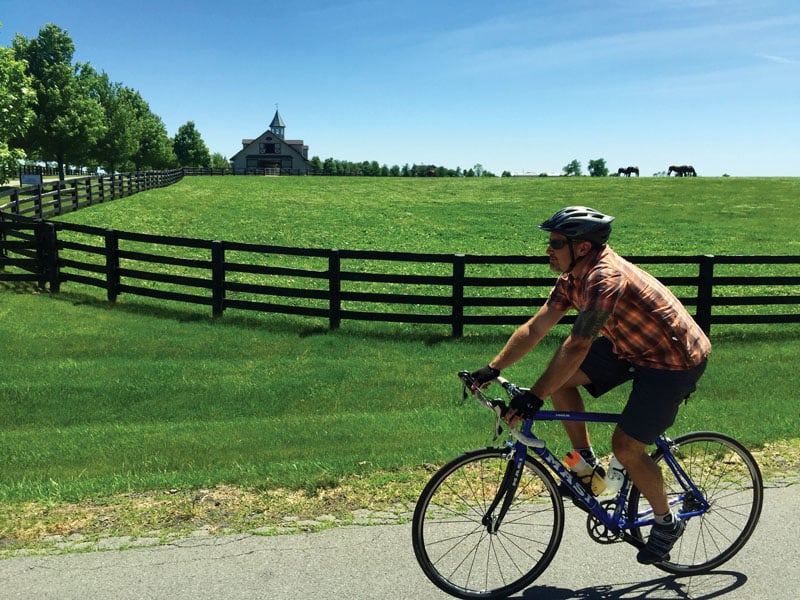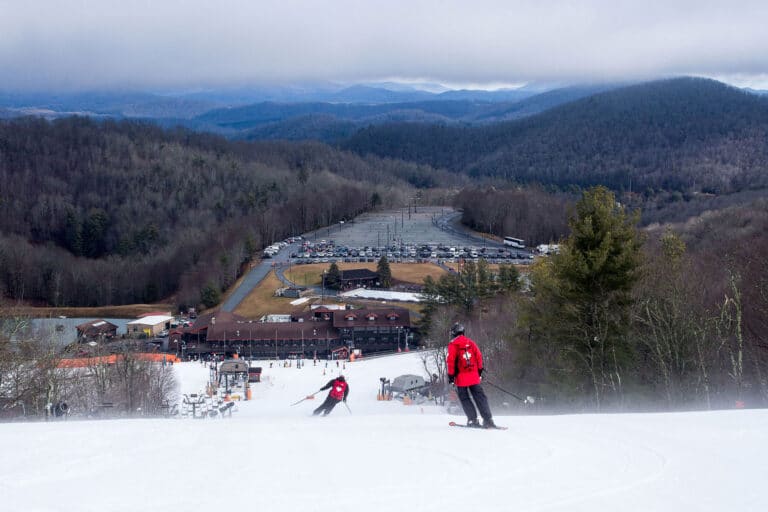I’m maybe six inches off Keener’s back wheel when we see the deer bounding through the tall grass. I’ve been drafting for the last few miles, so I’m fresh, maybe even a bit frisky, as I whisper to Keener, all excited, “Let’s race it!” Before I can finish the sentence, he’s out of his saddle and hammering up the road. The deer leaps ahead, looking at us between graceful arcs, maybe a little bit curious about our bikes, which might seem foreign in a landscape dominated by farm trucks and thoroughbred horses.
Your average adult deer can run 47 miles per hour. There’s no way we can beat this animal up the road, but it feels right to try. Maybe it’s the bourbon talking.
We’re in the midst of a 60-mile road ride through Kentucky’s horse country. The goal is to put in a big day on the bike, connecting four whiskey distilleries along the Bourbon Trail, a loosely defined driving route between Lexington and Louisville. On paper it sounds awesome. In reality, it’s even better. Four of us have made the trip—myself, Keener, Dusty and Kevin. We like to ride bikes, and we like to drink bourbon, so trading the steep Appalachians for Kentucky’s more mellow, rolling terrain seems like a no brainer. We’re used to suffering up steep mountain passes on our weekly mountain and road rides around Asheville, so we’re giddy from the lack of climbing when the opportunity to race a deer presents itself.
Of course, the animal is just toying with us. After 30 seconds of somewhat competitive racing, she charges ahead, creating a gap, then cuts hard left, leaping over a four foot tall dry stack wall, and crosses the street a few feet in front of Keener. He smiles: “That was just like that scene in Highlander!” (Google it, you won’t be sorry).
It’s hands down the most exhilarating experience I’ve ever had with an Odocoileus virginianus (fancy talk for white tailed deer) and the ride is only going to get better from here.
The Bluegrass State
This is what I know about Kentucky: KFC was created here. The Red River Gorge is a huge sport climbing mecca. Ashley Judd is a huge fan of Kentucky basketball…and that’s about it. Oh, and they make bourbon here. A lot of bourbon. In the 80 or so miles between Lexington and Louisville, there are at least 20 distilleries, including some of the most storied whiskey producers in the world. Places like Buffalo Trace, Wild Turkey, and Four Roses. You can connect most of those distilleries via laid back, country roads, making for a picture perfect road trip—green hills and black horses roll past your window between distillery tours and tastings.
It’s even better from the seat of a bike.
We start at the crack on 9:30am, in downtown Lexington, riding past massive graffiti murals, train tracks and warehouses that have been converted into art studios, but we quickly trade the hip industrial vibe for pastoral farm country. The road we’re riding runs north from downtown, straight as an arrow, but never stagnant. It’s constantly undulating with big, fast downhills followed immediately by equally big uphills. The key is to get into a rhythm where you tuck and pedal hard on the descents, then stand and hammer to the top of the next hill without changing gears.
To the right of us are expansive horse farms with manicured meadows rolling onto the horizon. The farms are divided by four-board fences, all painted matte-black and a perfect dry stack wall, about four feet high, runs along the side of the road, separating the pavement from the pastoral scene behind it. I imagine that wall runs all the way until the road hits Ohio, then it probably transitions into your standard guardrail. Herds of black thoroughbreds frolic in the grass, their hair shimmering in the bright sun. Occasionally, you’ll get a peek at a mansion, way off in the distance, big and garish and dominating the landscape.
On the left side of the road, it’s the exact same thing. I had this vague and stereotypical notion of Kentucky’s horse country as a land of mint juleps and women in giant straw hats, but I wasn’t expecting anything like this. It’s a weird blend of old world charm, opulence, and natural beauty, and it’s like nothing any of us have ever experienced before. Our typical road rides are hellish suffer fests where we grind up mountain passes to be rewarded with brief but beautiful long-range views. Here, in horse and bourbon country, the reward is immediate and constant. The scenery never stops. And of course, there’s bourbon.
We hit Buffalo Trace at mile 27. It’s a sprawling, industrial complex of historic rick houses, production facilities, offices, and a polished visitor’s center. There’s a cafe where you can sit and have a BBQ sandwich while watching barrels roll from one building to the next on an ingenious rail system—like a roller coaster for whiskey barrels. Buffalo Trace is one of the oldest distilleries in the country, operating in some form or another for more than 200 years. Their standard bourbon is a fine whiskey, but the distillery is also responsible for producing some of the most cherished bourbons in the world—your Van Winkles, your Blanton’s, and your Stagg Jr.’s.
We cut straight to the tasting room, blending into a tour group, where a guide pours us each an ounce of Eagle Rare and an ounce of Buffalo Trace. The Eagle Rare is the more expensive of the two, but it has a sharp edge to it. The Buffalo Trace is sweeter, more mellow. Getting to taste these bourbons side by side is educational. You start to appreciate the nuances of different mash bills and barrel treatments.
For the first few miles between Buffalo Trace and our second distillery, we’re stuck on a busy four-lane highway, where semi trucks pass us at 60mph, so we pull up the route on my phone and find an alternate road that adds miles but takes us through a quiet neighborhood, then drops us through a narrow canyon on a gravel road. It feels like Pisgah, dark and shrouded by towering hardwoods.
Using the phone feels like cheating. The guys I’m riding with have a long history of doing stupid adventures together. We’ve been lost in the woods together, nearly hypothermic together, hid from snowstorms in forest service bathrooms together…but this bourbon ride is more civilized. We’ve stopped for snacks. We’ve pulled over just to google the answers to nagging questions.
A sample of our google searches during the trip: That scene from Highlander. Does the Spearmint Rhino have a dress code? How far is it to the moon? When was KFC founded?
There’s a moment on that gravel road where we question our route, but Dusty puts it in perspective for us: “If things get too bad, we could always just call Uber for a ride.”
The gravel road dead ends into a dilapidated castle, complete with stone turrets and a tall iron gate. It’s the original Taylor distillery, built by bourbon pioneer Colonel E.H. Taylor in the 1880s. It’s hard to imagine bourbon today without Colonel Taylor. He was the first distiller to advocate for climate-controlled rick houses (before him, few people were even aging their whiskey). He pushed for the “Bottled in Bond” act, the first law to govern what you could label as bourbon. And he singlehandedly invented distillery tourism in this country, starting with this castle, where he invited people to tour the production facility and picnic on the grounds.
We spend a few minutes peeking through the fence and admiring the straight up balls that it took to build a castle in the middle of Kentucky before pedaling on.
The road from the castle to Woodford Reserve is curvaceous and more humble than what we’ve been riding so far. It follows a river through smaller farms and forgotten towns where the restaurants are boarded up, and trailers are packed three deep into small lots. The state-of-the-art Woodford Reserve, with its modern distillery and parking lot filled with Mint Julep tour buses stands in stark contrast.
The visitor’s center is highlighted with copper finishes and wood reclaimed from an old barn. An ultra modern fireplace separates the lounge from the tasting room, and shelves of Woodford Reserve bottles are backlit by a glowing wall.
We don’t have the patience to wait for the next tour group so we buy a bottle from the gift shop and find a picnic table under a tree and drink small pours of whiskey from plastic water cups and eat Clif Bars while watching guys in pastel golf shirts and women in sun dresses file into the distillery from tour buses.
HORSESHOES
We have two options as we pedal the 20 miles back to Lexington. Hammer, and try to hit one more distillery before it closes, or meander and stop at this little restaurant that has cold beer and a backyard with picnic tables and horseshoe pits.
Naturally, we stop for beer and horseshoes. We can hear goats from the farm next door laughing as we divide into teams and drink a local lager called Cougar Bait. The horseshoes gets competitive quickly, and one beer turns into two, which turns into three.
We still have 10 miles to pedal back into town, where we’ll race each other, tucking deep into the downhills to stay out of the wind. We’ll have another bar stop in the final mile of the ride–we’ll be passing one of those blocks of warehouses and I’ll hear Guns n’ Roses blaring, so we’ll pull into the gravel lot and find a dive bar with a fire pit. We’ll drink there for an hour and make plans for our return trip to Kentucky, but that’s later in the day. Right now, it’s just horseshoes, cold Kentucky beer, and laughing goats.













